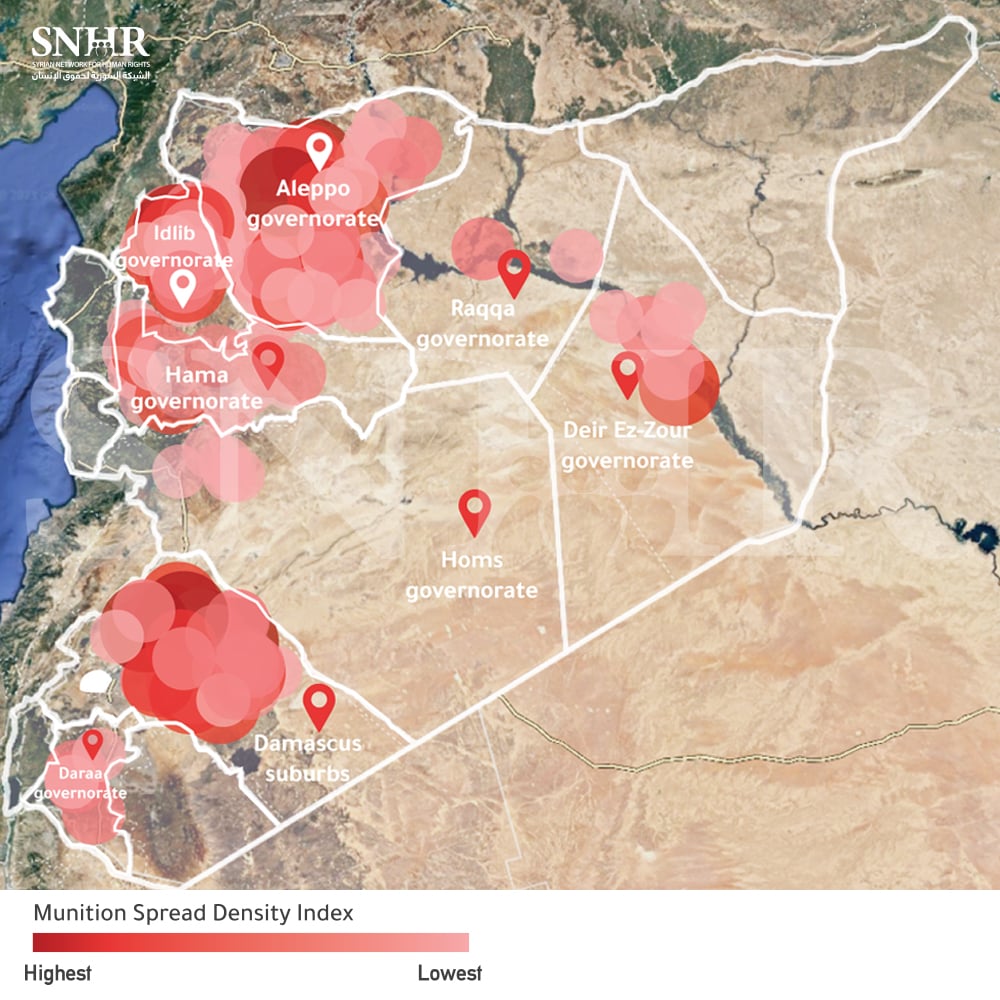A total of 1,435 Syrian citizens, including 518 children, killed by cluster munitions and their remnants used by the Syrian regime and Russia

Languages
Available In
Press release: (Download the full report below)
Paris – The Syrian Network for Human Rights (SNHR) warned in its report released today that cluster munitions are an open-ended threat to the lives of Syria’s future generations. The report includes maps showing the areas where cluster munitions remnants were dispersed across many Syrian governorates. SNHR further reveals that a total of 1,453 Syrian citizens, including 518 children, have been killed by cluster munitions and their lethal submunitions and other remnants used by the Syrian regime and Russia in Syria.
The 43-page report stresses that, for the past 11 years, vast areas of Syria have been subjected to repeated and heavy bombardment using cluster munitions, at first solely by the Syrian regime, then also by Russian forces following the launch of Russia’s military intervention. Furthermore, hundreds of attacks were directed at civilian targets, including agricultural land and areas populated by civilian residents, killing, and injuring many Syrian citizens. In this context, the report highlights patterns that emerged in the use of these indiscriminate munitions by the Syrian-Russian alliance forces. As the report explains, cluster munitions are particularly dangerous because of their long-term impact which lasts long after long after the wars or conflicts in which they were used have ended. Approximately10 to 40 percent of the cluster submunitions or bomblets from each bomb do not explode on the initial impact, meaning they continue to pose a lethal threat to other civilians, in addition to the victims killed by the initial explosion. The report stresses that hundreds of cluster submunitions in Syria have effectively turned into deadly miniature landmines that can kill or maim civilians, as well as cause serious injuries.
Fadel Abdul Ghany, Executive Director of SNHR, says:
“Every cluster munitions attack means that dozens or maybe hundreds of remnants, as high a proportion as 40 percent of the original quantity of submunitions deployed, did not explode, leaving them as lethal miniature landmines that can claim the lives of the residents of the area targeted. One of the reasons that compelled us to release this comprehensive report is the fact we have been regularly documenting new deaths and injuries from cluster munitions remnants. This also impelled us to design maps that illustrate the locations where cluster munitions were dispersed as a way to warn the residents when moving or cultivating land in those areas, and for the controlling forces to mark those areas and put them out of bounds, while making a serious effort to remove these lethal weapons.”
As the report reveals, the first documented use of cluster munitions in Syria dates back to July 2012, with the Syrian regime and Russian forces being the only two parties to have used cluster munitions in the country. The report highlights some of the specific and immense challenges in assigning culpability for killings and injuries from cluster submunitions that exploded later rather than at the time of the attacks which had left them as miniature landmines. In such cases, the report explains, responsibility is assigned jointly to the Syrian-Russian alliance.
The report draws primarily upon SNHR’s database of extrajudicial killings, as well as on our database for cluster munitions attacks, incorporating a hybrid methodology grounded in a statistical methodology, as well as a statistical analysis methodology that we have relied upon to analyze the data at hand. Furthermore, the report also adopted a chronological system in examining the context of cluster munitions use in Syria. Lastly, SNHR used an analytical descriptive methodology in creating the maps showing the areas where cluster submunitions were scattered.
The report summarizes some aspects of cluster munitions use in Syria since 2012, highlighting the unprecedented escalation in the use of this type of weapon following the launch of Russia’s military intervention on September 30, 2015. In this context, the report records no fewer than 496 attacks using cluster munitions between July 2012 and January 2023, with Syrian regime forces responsible for 251 of these attacks, and Russian forces responsible for another 237, while the remaining eight were categorized as joint Russian/Syrian attacks. Although it is quite difficult to accurately assess the number of injuries resulting from the explosion of cluster submunitions, the report notes, SNHR estimates that around 4,410 civilians have been injured by these lethal weapons, with many of these individuals needing to have limbs amputated as a result of their injuries, and still requiring artificial limbs and rehabilitation and support programs.
The report also summarizes some of the most prominent patterns of cluster munitions use which SNHR has been able to identify. According to our estimates, at least 20 types of cluster munitions have been used in Syria by the Syrian-Russian alliance forces. To provide an example of the range of cluster munitions used, the report uses the year 2016 for a case study, since that year saw approximately 38 percent of all attacks involving the use of cluster munitions that have been carried out in Syria, presenting the findings of this study as an analytical model.
Moreover, the report presents some maps showing the approximate locations that we suspect are contaminated with remnants and submunitions left from cluster munitions attacks, so as to alert local residents to avoid those locations. The report notes, however, that these maps reflect the bare minimum of the scope of these submunitions’ dispersal, stressing the various challenges presented in creating those maps all of which, in one way or another, affect the areas we have been able to pinpoint. These maps have been designed in a way that shows the areas which saw a high frequency of cluster munitions attacks and a high death toll.
The report reveals that, as of January 2023, a total of 1,053 civilians, including 394 children and 219 women, have been documented killed in attacks involving cluster munitions in Syria since the first documented use of cluster munitions in the country in July 2012. Among the victims are six medical personnel, one media worker, and three civil defense members. According to the report, cluster munitions attacks carried out by Syrian regime forces have resulted in the deaths of 835 civilians; including 337 children, 191 women, five medical personnel, and two civil defense members; meanwhile, 218 civilians; including 57 children, 28 women, one medical worker, one media worker, and one Civil Defense member, were killed by cluster munitions attacks carried out by Russian forces. The report includes a running count of the death toll, as well as graphs showing the distribution of deaths by year and by governorate. Analysis of the data shows that 42 percent of all deaths resulting from cluster munitions attacks were documented in 2016, with Syrian regime forces responsible for approximately 63 percent of that year’s cluster munitions-related deaths.
The report also reveals that, as of January 2023, no fewer than 382 civilians, including 124 children and 31 women, had been killed by the explosion of cluster submunitions left from previous cluster munitions attacks carried out by the Syrian-Russian alliance forces.
The report stresses that the use of cluster munitions by Syrian regime forces and Russian forces constitutes a violation of both the principles of distinction and proportionality of international humanitarian law, which qualifies as a war crime. Furthermore, Syrian-Russian alliance forces have categorically violated Security Council resolutions 2139 and 2254 that call for ending indiscriminate attacks, as well as violating a large number of the rules of customary international humanitarian law. Moreover, through the crime of murder, the Syrian-Russian alliance’s forces have violated Article 7 & 8 of the International Criminal Court’s Rome Statute, with these violations constituting war crimes and crimes against humanity.
The report adds that the Russian regime has additionally been involved in backing the Syrian regime, which has committed crimes against humanity and war crimes against the Syrian people, through shielding the regime politically on the international stage, as well as through supplying the Syrian regime with weapons and military expertise. This has been abundantly clear since the start of Russia’s direct military intervention in favor of the Syrian regime. Supporting a regime that has been involved in crimes against humanity constitutes a categorical violation of international law and makes Russia subject to accountability.
The report calls on the Security Council to adopt a special resolution prohibiting the use of cluster munitions in Syria, as with the prohibition of the use of chemical weapons. This resolution should also address how to remove the remnants of this dangerous weapon. The report also stresses that Russia’s permanent Security Council membership should not be a barrier to the Security Council holding it accountable, warning that failure to hold Russia accountable means the Security Council will lose its remaining credibility.
Additionally, the report calls on the Office of the UN High Commissioner for Human Rights to condemn the widespread and excessive use of cluster munitions against civilians in the Idlib area and to submit a letter to the Security Council on this issue, in addition to making a number of other recommendations.


